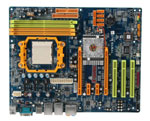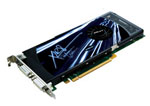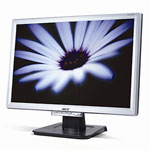November 2007 Budget Buyers' Guide
by Jonathan Maloney and Jarred Walton on November 8, 2007 4:00 AM EST- Posted in
- Guides
AMD Budget Gaming
Leaving the entry-level sector behind, and with a budget of roughly $1000, our options increase significantly. Our aim here is to provide a configuration that allows for a nice balance of performance at stock speeds, while also giving capability and headroom for overclocking. This doesn't mean you have to spend over $1000 though, as we can trim some of our more extravagant options to keep the price to around $950 - a slightly slower CPU, a smaller hard drive, or even a smaller LCD will all help keep our budget to under $1000. For now however, this remains our pick for a budget gaming system that will carry you through the next round of DX10 titles coming our way - and all with nary a red face in sight.
Although current wisdom tells us GPU performance is more of a factor than CPU numbers, at resolutions of 1280x1024 and below - or with RTS and simulation games - the CPU can still play a role in framerates. Frequently it can be the line between a game being playable and a desire for a bigger and better video card. At resolutions of 1680x1050 and higher, games generally become less CPU-bound than before, and the focus is definitely on the GPU. For our budget gaming system, we've picked the Athlon X2 5000+. Running at 2.6GHz, this offers more than enough performance for current games and at an excellent price.
For overclockers, the Black Edition with its unlocked multiplier is certainly an interesting alternative. At $20 more than the standard X2 5000+ Windsor core, the addition of an unlocked multiplier and a 65W Brisbane core is very attractive - at least from an enthusiast perspective. Users across our forums are hitting speeds in excess of 3.3GHz (we hit 3.6GHz with water cooling), and at speeds above AMD's highest X2 offering - the X2 6400+ - this is a budget overclocker's dream. However, you need some sort of cooling for the CPU, as the Black Edition doesn't include a heatsink. You might have a spare, but if you don't and you prefer not to break the bank, we'd recommend the Scythe Ninja Plus Rev. B. That's a pretty hefty price increase purely for overclocking, so we're listing that as an alternative that would add a total of $55 to the system price.
We've paired the X2 5000+ Black Edition with the Biostar TForce TF570SLI, a perfect match for those looking to squeeze as much performance out of their money as possible. The inclusion of dual PCI Express x16 allows users to add a second video card later, budget permitting. The NF570 SLI chipset may have been on the market for some time now, but it's certainly not in the same category as the budget IGPs from AMD, Intel, and NVIDIA. Aside from name changes and added feature sets, the performance of the NF570SLI is still top-notch. Given that NVIDIA skipped the NF6 chipset for AMD systems, and that the AMD 690G and GeForce 7000 series is IGP (and therefore less overclocking-friendly to some degree), we feel this is the best low-budget option for performance and build quality. The SLI support really isn't necessary, although the 8800GT is warming us to SLI quickly in part to Cyris. It's still difficult to find any reasonable alternatives that would save money and still be worth considering so this board is a logical choice.
We're sticking with the Ballistix sticks for now (at the time of writing the $40 rebate offer was still valid for another ten days); however, options are plentiful for a budget of $50 should Crucial decide against renewing their rebate deal. Quality DDR2-800 RAM from Corsair, OCZ, G.Skill, Mushkin, and GeIL are available on any of the major online retailers. Just be sure to look for RAM with timings of 4-4-4-12 - or luck permitting, with Micron D9GMH ICs.
As the heart of any gaming system, what can we choose for the video card? Just two weeks ago, the 8600 GTS would have been a likely candidate - or perhaps the 8800 GTS 320MB for those willing to spend more money - and performance would have varied from being mildly underwhelming to being pretty good. Right now, however, and at a delightful $250 price point, NVIDIA has the brand new 8800 GT 512MB based around the G92 core - essentially a die shrink from 90nm to 65nm, with some other tweaking involved. Performance is phenomenal for this price; benchmarks show results that nip at the coat tails of the 8800 GT's bigger brothers - the $500 8800 GTX, and at resolutions lower than 1920x1200, even the $700 8800 Ultra.
The remaining components have received slight upgrades over our entry-level configuration. We bumped up to a 320GB hard drive, still from Samsung. If you'd prefer a longer warranty, look at Western Digital or Seagate (but be prepared to spend a few dollars more). We selected a Raidmax Apex case with a 400W PSU, and we managed to include a laser keyboard and mouse set and 5.1 speakers both from Logitech. Again, on the overclocking side of things, seriously consider a better PSU if you can manage it.
We faced the same issue that often appears in our Budget/Midrange Guides when it came to the display selection. We could have selected a cheap 22" from Hanns-G - the HG-216DPO that retails at just $214.99 - but instead we went with a higher quality 20" Acer AL2016W, saving us $35 in the process.
We get all this in a system that retails for a little over $1,000? What more could you want? If you want to upgrade or downgrade any of the areas, there are plenty of options. The 4000+ CPU from the base system would still be sufficient for most gaming, a smaller hard drive only impacts storage capacity, and the slightly larger display isn't strictly necessary either. In terms of upgrades, you can look at our last Midrange Guide for some alternatives.
Leaving the entry-level sector behind, and with a budget of roughly $1000, our options increase significantly. Our aim here is to provide a configuration that allows for a nice balance of performance at stock speeds, while also giving capability and headroom for overclocking. This doesn't mean you have to spend over $1000 though, as we can trim some of our more extravagant options to keep the price to around $950 - a slightly slower CPU, a smaller hard drive, or even a smaller LCD will all help keep our budget to under $1000. For now however, this remains our pick for a budget gaming system that will carry you through the next round of DX10 titles coming our way - and all with nary a red face in sight.
| AMD Budget Gaming PC | |||
| Hardware | Component | Price | Rebates |
| Processor | AMD Athlon X2 5000+ (2.6GHz 89W Windsor 2 x 512KB L2) |
$110 | - |
| Motherboard | Biostar TForce TF570SLI AM2 nForce 570SLI ATX |
$88 | - |
| Memory | Crucial Ballistix 2GB (2x1GB) DDR2-800 PC2-6400 | $90 | $40 |
| Video Card | PNY GeForce 8800GT 512MB PCI-e 2.0 HDCP | $260 | - |
| Hard Drive | Samsung SpinPoint T Series HD321KJ 320GB 16MB 7200RPM SATA 3.0GB/s |
$75 | - |
| Optical Drive | Samsung 20X DVDRW/DL SH-S202G | $28 | - |
| Case | APEX TU150 Black Steel ATX with 400W | $59 | - |
| Display | Acer 20" AL2016WBbd 5ms Widescreen DVI (1680 x 1050) |
$200 | - |
| Speakers | Logitech X-530 70W RMS 5.1 | $55 | - |
| Input | Logitech LX-710 Laser Black USB | $55 | - |
| Operating System | Microsoft Vista Home Premium OEM | $112 | - |
| Bottom Line | $1132 | $1092 | |
 |
For overclockers, the Black Edition with its unlocked multiplier is certainly an interesting alternative. At $20 more than the standard X2 5000+ Windsor core, the addition of an unlocked multiplier and a 65W Brisbane core is very attractive - at least from an enthusiast perspective. Users across our forums are hitting speeds in excess of 3.3GHz (we hit 3.6GHz with water cooling), and at speeds above AMD's highest X2 offering - the X2 6400+ - this is a budget overclocker's dream. However, you need some sort of cooling for the CPU, as the Black Edition doesn't include a heatsink. You might have a spare, but if you don't and you prefer not to break the bank, we'd recommend the Scythe Ninja Plus Rev. B. That's a pretty hefty price increase purely for overclocking, so we're listing that as an alternative that would add a total of $55 to the system price.
 |
We're sticking with the Ballistix sticks for now (at the time of writing the $40 rebate offer was still valid for another ten days); however, options are plentiful for a budget of $50 should Crucial decide against renewing their rebate deal. Quality DDR2-800 RAM from Corsair, OCZ, G.Skill, Mushkin, and GeIL are available on any of the major online retailers. Just be sure to look for RAM with timings of 4-4-4-12 - or luck permitting, with Micron D9GMH ICs.
 |
The remaining components have received slight upgrades over our entry-level configuration. We bumped up to a 320GB hard drive, still from Samsung. If you'd prefer a longer warranty, look at Western Digital or Seagate (but be prepared to spend a few dollars more). We selected a Raidmax Apex case with a 400W PSU, and we managed to include a laser keyboard and mouse set and 5.1 speakers both from Logitech. Again, on the overclocking side of things, seriously consider a better PSU if you can manage it.
 |
We get all this in a system that retails for a little over $1,000? What more could you want? If you want to upgrade or downgrade any of the areas, there are plenty of options. The 4000+ CPU from the base system would still be sufficient for most gaming, a smaller hard drive only impacts storage capacity, and the slightly larger display isn't strictly necessary either. In terms of upgrades, you can look at our last Midrange Guide for some alternatives.










63 Comments
View All Comments
JarredWalton - Tuesday, November 13, 2007 - link
Don't forget the display! That adds about $200 if you use the display we selected, so you save a bit of money but get a smaller HDD (1/4 the size), a GPU that's not half as fast as the 8800 GT, and I'd use something other than the ASUS M2A-VM if you're going to have a discrete GPU in there. I'm a bit confused as to whether you were shooting for "budget" or "budget gaming".I try not to repeat stuff on every page, as I assume (possibly incorrectly) that people will read the article as a whole. We do mention the option to get a better PSU on the Intel Gaming page. The reality is, all the good PSUs start at around $60 (PCP&C 360W is $58 shipped). I figure you either get one of the 80% Energy Efficient Certified models, or go with whatever comes with your chosen case.
Hope that clarifies things a bit - we're not saying these systems are the *only* way to go right now, as individual needs will vary. If you're looking at gaming, though, I don't think I'd get anything less than the 8800 GT these days. You can cut corners elsewhere to your hearts content, but there are quite a few titles out that now require a lot of GPU power even at moderate resolutions. (Hellgate: London, for example, is pretty sluggish even on a single 8800 GTX! Same goes for the Crysis demo.)
Crassus - Friday, November 9, 2007 - link
Just as an aside - I remember frequent references to the Anandtech Real Time Pricing (labs.anandtech.com) in the old buyer's guides. That seems to have completely disappeared. I wanted to look up something there and I only get error messages, both in Firefox and IE. Is it me or is it you?phusg - Friday, November 9, 2007 - link
Thanks for the article. Just one grammatical mistake that really grates me:"Even though the Intel system comes in at a lower price" is fine.
"Even though the Intel system is cheaper" is fine.
is not!
Polizei - Friday, November 9, 2007 - link
Bravo, Bravo. I just wanted to say that I greatly appreciate this article. I'm an avid computer enthusiast and have followed Anandtech, HardOCP, and CPU magazine for years. That said, I've never felt it necessary to become involved in the forum thread posting until this article. Far too many websites seem to ignore the fact that stable, overclockable, affordable, and high-performing parts are available if someone needs to go that route. $2,000-$6,000 high-performance gaming systems are often regarded as a must-have for every enthusiast, which limits a great deal of modern society if they so choose to game, watch movies, or just want a faster computer. So again, my hat is off to you guys for finally stepping up and putting together a very good guide for lower-priced rigs that actually don't suck and crash every 5 minutes. Not sure if you follow competitors at all, but Maximum PC Magazine recently did a similar article and it was just atrocious as to how they approached it - http://www.maximumpc.com/article/the_500_pc_build_...">http://www.maximumpc.com/article/the_500_pc_build_...wjl - Friday, November 9, 2007 - link
First: the Intel CPUs mentioned here are not able to support hardware virtualization, which is a major issue for me. You have to get a Core 2 Duo 6xxx for that purpose, and they are still pretty more expensive than AMD's offerings, which all (except the low-end Sempron line) support VT-X (they call it Pacifica).Second: As mentioned here before, considering and testing compatibility with Linux is especially with the low budget model a major issue as well. Integrated Intel graphics would be better in that regard, because they open sourced most of their graphics drivers. For an AMD system, open source drivers will be coming, but at the moment those from nVidia should perform better - and you can select whether you want to use the free nv driver or the unsupported but free (as in beer) proprietary driver from nVidia.
Third: As of today, you should think a bit about the "green" factor. Most of todays CPUs are more than fast enough for any serious work we could throw at them, except maybe video processing. Selecting CPUs like the AMD BE series (with 45W max) or even lower level Intel chips (without virtualization capabilities, as mentioned before) should have been considered. There's also much to think about when it comes to power supplies and so on.
Maybe it's interesting to look at the "Solar PC", built from the guys over at Tom's Hardware in Munich? They ended up with a systems which consumes about 61W when idle - including the monitor! Of course, here Laptops really shine.
With low-cost NAS devices like the IcyBox (or MaPower) available, you could even have thought about thin clients or thin-client-like new offering like the Asus Eee PC (like Asus say, they are selling one each 6 seconds now). For 400$ or 300€, you'll get a neat little machine which can do most of what people want to do with their computers today. Add the same price for a RAID1 NAS, which can be shared within your household, and you'll have the perfect "green" setup.
kind regards,
wjl aka Wolfgang Lonien
(you'll find more thoughts from me on the topic on my pages in the interweb)
Calin - Friday, November 9, 2007 - link
Yes, the 800x480 pixels monitor on an Asus Eee will do great, especially in Windows with its fat themes (XP with default theme, Vista with default theme).Hardware virtualization might be a problem, though I hear it isn't much used for performance reasons.
Low power processors? All the way. By the way, you could get low power from a normal processor by undervolting (and maybe underclocking). Not sure if it's possible on the chosen mainboards.
wjl - Friday, November 9, 2007 - link
Who needs Windows to write a letter or surf the net? I hope that system will be history soon, like the dinosaurs...strikeback03 - Tuesday, November 13, 2007 - link
Considering that the average website these days is designed to target a minimum of 1024x768 resolution, surfing on a smaller screen can be a pain.tomoyo - Friday, November 9, 2007 - link
A gamer would never pick a 5ms TN-Film lcd. Those have a lot of ghosting issues compared to 2ms TN-films.tomoyo - Friday, November 9, 2007 - link
First of all, many components are completely unexplained. Second I dislike a number of the choices, the most major issue being the case/psu. Both case and psu picked are from very low quality makers. These are the types of psus that tend to explode with major load. They should never be recommended to users of anandtech. I'd like to see some more detailed research and explanations that go with a focus on good quality components, rather than trying to keep to some cutrate budget.